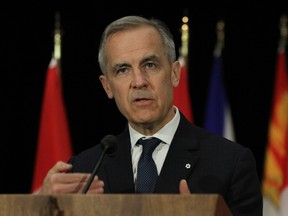
Article content
Canada’s Liberal government says it wants to get spending under control, an unnamed previous government having let it get badly out of control. The finance minister has instructed his cabinet colleagues to review spending and find billions of dollars in savings. This is a welcome sign. But it needs to be taken in context.
THIS CONTENT IS RESERVED FOR SUBSCRIBERS ONLY
Subscribe now to read the latest news in your city and across Canada.
- Exclusive articles from Barbara Shecter, Joe O'Connor, Gabriel Friedman, and others.
- Daily content from Financial Times, the world's leading global business publication.
- Unlimited online access to read articles from Financial Post, National Post and 15 news sites across Canada with one account.
- National Post ePaper, an electronic replica of the print edition to view on any device, share and comment on.
- Daily puzzles, including the New York Times Crossword.
SUBSCRIBE TO UNLOCK MORE ARTICLES
Subscribe now to read the latest news in your city and across Canada.
- Exclusive articles from Barbara Shecter, Joe O'Connor, Gabriel Friedman and others.
- Daily content from Financial Times, the world's leading global business publication.
- Unlimited online access to read articles from Financial Post, National Post and 15 news sites across Canada with one account.
- National Post ePaper, an electronic replica of the print edition to view on any device, share and comment on.
- Daily puzzles, including the New York Times Crossword.
REGISTER / SIGN IN TO UNLOCK MORE ARTICLES
Create an account or sign in to continue with your reading experience.
- Access articles from across Canada with one account.
- Share your thoughts and join the conversation in the comments.
- Enjoy additional articles per month.
- Get email updates from your favourite authors.
THIS ARTICLE IS FREE TO READ REGISTER TO UNLOCK.
Create an account or sign in to continue with your reading experience.
- Access articles from across Canada with one account
- Share your thoughts and join the conversation in the comments
- Enjoy additional articles per month
- Get email updates from your favourite authors
Sign In or Create an Account
or
Article content
Prime Minister Mark Carney’s most recent fiscal document was his campaign platform, which included more than $30 billion in annual “new investments” on top of the fiscal plan he inherited from that previous government. Some of this was for a modest income tax cut and cancelling the planned capital gains tax hike, but most was for new spending. So something like $20 billion in annual spending must be removed from Carney’s most recent fiscal projection just to get the federal government back to Justin Trudeau’s spending plan, which was already a model of fiscal irresponsibility.
Article content
Article content
Article content
As if things weren’t bad enough, Carney’s higher spending path was before his recent promises of big new defence spending. The C.D. Howe Institute estimates that, all told, the federal deficit may hit $92 billion this fiscal year, more than double the government’s projection back in March. And Carney’s often-used slogan of “Spend Less, Invest More” suggests any “savings” from a spending review may not actually translate into taxpayer relief. The government may simply spend the money on something else and call it an “investment.” Finally, while reviewing spending, the government said it does not intend to touch its national child care and dental care programs, both boondoggles in terms of cost and quality of service. In sum, the Carney government does not seem at all serious about finding real efficiencies and savings.
Article content
By signing up you consent to receive the above newsletter from Postmedia Network Inc.
Article content
Which is a pity. There are many opportunities to save billions of dollars outside child care and dental care. Begin with the Department of Agriculture and Agri-Food. The 2025-26 estimates, which tell us the department was created in 1868 “because of the importance of agriculture to the economic, social and cultural development of Canada,” put its cost at $3.9 billion this fiscal year. But agriculture’s being important to Canada’s economic development, which it certainly was and is, does not require it to be centrally planned by a government agency. In fact, something being important is a good argument against centrally planning it. To save $3.9 billion annually, take the Department of Agriculture and Agri-Food budget down to $0. Separately, the Canadian Grain Commission and Canadian Dairy Commission would be good for another $33 million in annual savings. Scrap them, too.
Article content
Article content
The Department of Industry, another large federal agency whose main purpose is unnecessary economic intervention, should also be eliminated (at a savings of $8.6 billion). Add to this the federal government’s corporate welfare — or, as the government calls them, economic development — agencies. There are multiple regional agencies for: Atlantic Canada ($362 million), the North ($78 million), the Prairies ($279 million), Quebec ($331 million), Northern Ontario ($72 million), Southern Ontario ($268 million) and British Columbia ($140 million). Canada’s taxpayers and economy would be better off without them. Axe these, too.
Article content
Article content
According to the estimates, the Department of Finance will pay $3.5 billion to the Canada Infrastructure Bank this year, a crown corporation in the news recently for financing ferry purchases from China. Its establishment in 2017 was a poor idea to begin with. Again, the appropriate amount for this is $0. Three more pieces of low-hanging fruit are VIA Rail ($1.9 billion including its subsidiary VIA HFR-VIA Inc., whose mandate is to develop and implement high-frequency rail), the Canadian Broadcasting Corporation ($1.4 billion) and Canada Post Corporation ($1.1 billion).

.jpg) 12 hours ago
1
12 hours ago
1
 English (US)
English (US)